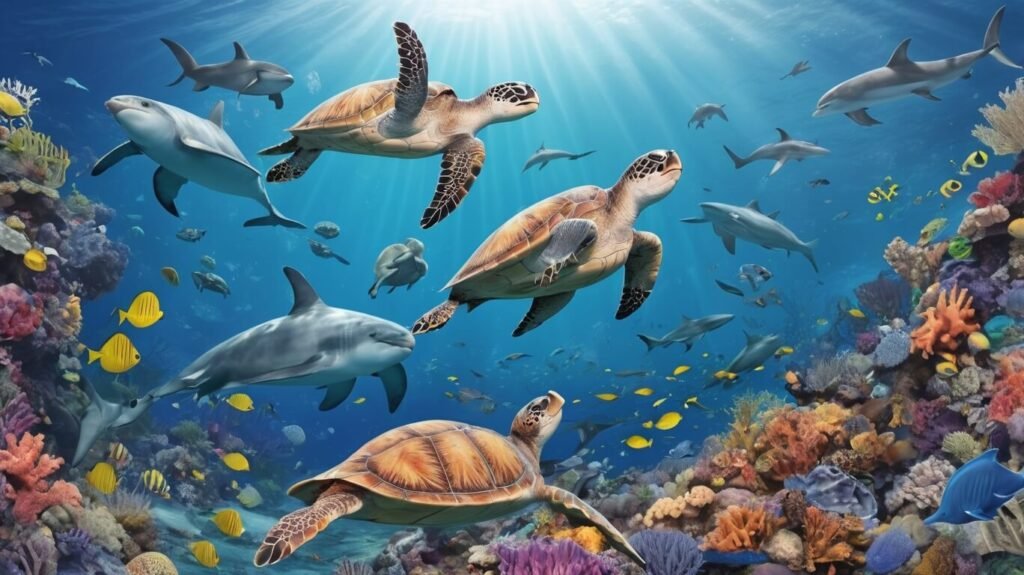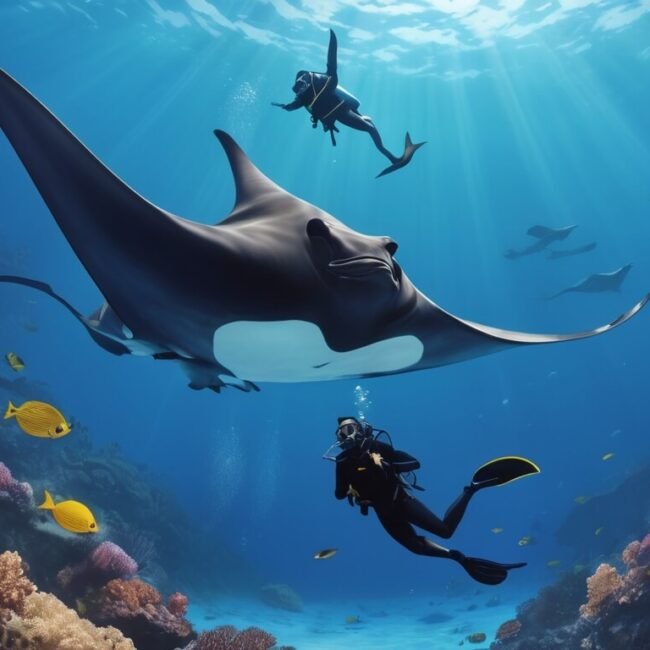Diving introduces us to a whole new world, filled with mesmerizing marine creatures that inspire awe and wonder! Did you know that over 70% of the Earth’s surface is underwater, hosting an incredible variety of life? Whether you’re an experienced diver or planning your first underwater adventure, this guide showcases the most spectacular marine animals you can encounter. Let’s dive in and explore the ocean’s most amazing residents, from gentle giants to elusive predators!
Majestic Manta Rays: The Ocean’s Gentle Giants
Why manta rays are a favorite among divers
You know, if there’s one marine animal that always leaves me in awe, it’s the manta ray. These gentle giants are like the ballet dancers of the sea, gliding effortlessly through the water with wingspans that can reach up to 23 feet! The first time I encountered a manta ray, I was absolutely floored. I mean, imagine looking up and seeing this massive creature soaring above you—it’s wild!
Divers adore manta rays not just for their size but for their curious and playful nature. They often swim loops around divers, almost as if they’re as fascinated by us as we are by them. It’s hard not to feel a connection when a manta locks eyes with you during a dive.
One time in the Maldives, I was lucky enough to witness a group of mantas feeding in a cyclone formation. It was like watching an underwater tornado of marine animals swirling gracefully. Moments like these are what make diving such an addictive hobby!
Where to find manta rays, including hotspots like the Maldives and Hawaii
If you’re itching to see manta rays in their natural habitat, there are a few hotspots you shouldn’t miss. The Maldives is a top destination, especially Hanifaru Bay in Baa Atoll. Between May and November, this area becomes a gathering point for hundreds of mantas. It’s seriously manta heaven!
Hawaii is another prime spot. The Kona Coast offers incredible night dives where mantas come to feed on plankton attracted by dive lights. Let me tell you, having a manta ray do a backflip right above you under the moonlit sky is something you’ll never forget.
Other awesome places include Yap in Micronesia and the Similan Islands in Thailand. Each location offers a unique experience with these majestic marine animals, so you might wanna add them all to your bucket list!
READ MORE: Top Hawaii Must-Visit Dive Sites for Adventure Seekers
READ MORE: Top Wreck Diving Sites in the Maldives: Explore Underwater History
How to interact respectfully with these gentle creatures
Now, as mesmerizing as manta rays are, it’s super important to interact with them responsibly. Always keep a respectful distance—getting too close can stress them out. I learned this the hard way when I accidentally spooked a manta during one of my early dives. Felt like such a rookie mistake!
Avoid touching or chasing them. Not only is it uncool, but it can also harm their delicate skin. Remember, we’re visitors in their home. Let them come to you, and you’ll have a much more rewarding experience.
Also, be mindful of your gear. Secure any dangling equipment that might hit or entangle them. And of course, follow any guidelines provided by your dive operator or local regulations. Respect for marine animals goes a long way in preserving these incredible encounters for future generations.

Sea Turtles: Ancient Navigators of the Seas
Overview of the common species of sea turtles divers might encounter
Sea turtles are like the wise old sages of the ocean. They’ve been cruising the seas for over 100 million years! The most common species you’re likely to encounter are the green sea turtle, hawksbill, and loggerhead.
Green sea turtles are often spotted grazing on seagrass beds. Hawksbills are smaller and have a distinctive beak-like mouth, perfect for munching on sponges. Loggerheads have massive heads and powerful jaws, ideal for cracking open crustaceans. Each of these marine animals brings its own charm to the underwater world.
I once spent nearly an entire dive just watching a hawksbill turtle nibble away at a reef in Bali. It was so engrossed in its meal that it didn’t even mind me hovering nearby. Moments like that make me appreciate the simple joys of life under the sea.
Best destinations to spot sea turtles, including the Great Barrier Reef and Bali
If you’re on the hunt for sea turtles, the Great Barrier Reef in Australia is a must-visit. It’s not just a world heritage site; it’s a bustling metropolis for marine animals, including six species of sea turtles!
Bali is another fantastic destination. Places like the Gili Islands are renowned for their abundant turtle populations. I’ve had turtles swim right alongside me there, almost like we’re old pals.
Other great spots include the Seychelles, Mexico’s Riviera Maya, and the beaches of Costa Rica. Each location offers unique opportunities to witness these ancient navigators in action.
READ MORE: Experience Great Barrier Reef Diving in Australia
Conservation efforts and how divers can help protect sea turtles
Sea turtles face numerous threats like poaching, habitat loss, and plastic pollution. It’s a harsh reality, but as divers and ocean lovers, we can play a part in their conservation.
Simple actions like not touching or disturbing turtles can make a big difference. Participate in beach clean-ups or support organizations dedicated to marine conservation. I once joined a turtle rescue program in Florida, and releasing rehabilitated turtles back into the wild was one of the most fulfilling experiences of my life.
Reducing plastic use is also crucial. Turtles often mistake plastic bags for jellyfish, which can be fatal. Every effort counts when it comes to protecting these magnificent marine animals.

Vibrant Coral Reef Fish: The Kaleidoscope of the Ocean
Types of reef fish, from clownfish to parrotfish
The coral reef is like a living rainbow, bursting with vibrant marine animals that captivate the eye. From the tiny clownfish hiding among the anemones to the colorful parrotfish chomping on coral, there’s always something fascinating to see.
Clownfish are not just adorable; they’re also incredibly interesting. They have a symbiotic relationship with sea anemones, gaining protection from predators while providing the anemone with food scraps. Talk about a win-win!
Parrotfish, on the other hand, are the reef’s resident artists. They nibble on algae-covered coral, and fun fact—they poop sand! Yup, much of that beautiful white sand on tropical beaches comes from parrotfish digestion. Kinda gross, but also pretty neat, right?
How coral reefs support marine biodiversity
Coral reefs are the bustling metropolises of the ocean. They cover less than 1% of the ocean floor but support about 25% of all marine life. That’s huge! These ecosystems provide food, shelter, and breeding grounds for countless species.
The reefs themselves are built by tiny organisms called coral polyps. Over thousands of years, they create massive structures that become the backbone of marine biodiversity. Without them, many marine animals wouldn’t have a home.
I can’t emphasize enough how crucial reefs are—not just for the ocean but for humans too. They protect coastlines from erosion, support fisheries, and even have potential medicinal uses. They’re like the unsung heroes of our planet.
READ MORE: Coral Reef Protection: How to Safeguard Our Oceans
READ MORE: Top Coral Reef Diving Destinations: Best Spots Worldwide
Tips for spotting these fish during your dives
If you want to make the most of your reef dives, here’s some insider advice. Move slowly and keep your eyes peeled. Many reef fish are masters of disguise, blending into the coral or hiding in nooks and crannies.
Look for movement and flashes of color. Sometimes the smallest shift can reveal a hidden gem. I often hang out near cleaning stations where fish congregate to be cleaned by smaller critters—it’s like witnessing an underwater spa session!
Also, consider diving at different times of the day. Dusk and dawn can offer glimpses of species that aren’t active during the day. Night dives are a whole different ballgame, revealing nocturnal marine animals that are nothing short of fascinating.
Above all, practice good buoyancy and avoid touching the coral. Not only does this protect the reef, but it also ensures you don’t harm yourself on sharp or stinging organisms. Respect the ocean, and it will reward you with unforgettable experiences.

Sharks: Awe-Inspiring Predators
Debunking common myths about sharks
Alright, let’s talk sharks. I know, I know—just hearing the word might send a shiver down your spine. But trust me, these marine animals are seriously misunderstood. The biggest myth? That sharks are bloodthirsty man-eaters lurking in the depths waiting to chomp on unsuspecting swimmers. Total nonsense! In reality, shark attacks are incredibly rare. You’re more likely to be struck by lightning than bitten by a shark.
I remember my first shark dive like it was yesterday. I was nervous as heck, palms sweaty inside my wetsuit gloves. But the moment I saw a sleek grey reef shark glide gracefully past me, all that fear melted away. These creatures are absolutely majestic! They’re not interested in us; they’re just going about their business, playing a crucial role in the ocean’s ecosystem.
Another myth is that all sharks are enormous and dangerous. In truth, there are over 500 species of sharks, ranging from the tiny dwarf lanternshark (which could fit in your hand) to the massive but gentle whale shark. It’s high time we give these incredible marine animals the respect they deserve.
Best shark-diving locations, such as South Africa and the Bahamas
If you’re keen to dive with sharks—and who wouldn’t be after learning the facts?—there are some epic spots around the globe you should check out. South Africa is a big one, especially the waters around Gansbaai, known as the “Great White Capital.” Cage diving there is a thrill like no other!
The Bahamas is another hotspot. Places like Tiger Beach offer up-close encounters with tiger sharks, lemon sharks, and even hammerheads. I had the most mind-blowing experience there when a massive tiger shark swam so close I could see the tiny scars on her snout. It was wild!
Other awesome locations include Fiji for bull sharks and the Galápagos Islands for schooling scalloped hammerheads. Each destination offers a unique experience with these awe-inspiring predators. So, grab your gear and get ready for an adventure of a lifetime!
Safety tips for diving with sharks
Diving with sharks is generally safe, but it’s crucial to follow some guidelines. First off, always listen to your dive guide—they know the local shark behavior best. Keep your movements smooth and avoid splashing around like a wounded fish. Sharks are attracted to erratic movements.
I learned the hard way not to wear shiny jewelry. On one dive, my flashy bracelet caught the attention of a curious reef shark. Talk about a heart-pounding moment! Also, stay within your depth and comfort level. If you’re not an experienced diver, consider starting with guided snorkeling trips.
Remember, these marine animals aren’t out to get you, but they deserve respect. Don’t try to touch or feed them. Maintain a safe distance, and you’ll have an unforgettable experience without any drama.

READ MORE: Diving with Sharks : Safety Tips and Myths Debunked
Nudibranchs: Tiny Yet Dazzling Creatures
Why nudibranchs are often called the “jewels of the sea”
Now, let’s shift gears to something smaller but no less fascinating—nudibranchs. These tiny sea slugs are like the hidden gems of the ocean. Seriously, they’re often called the “jewels of the sea” because of their vibrant colors and intricate patterns. They’re absolutely mesmerizing!
I was on a dive in the Philippines when I spotted my first nudibranch. It was this tiny, neon-blue creature crawling along a coral. I couldn’t believe something so small could be so stunning. Since then, I’ve become a bit obsessed. They’re like Pokémon—you gotta find ’em all!
These little marine animals come in an incredible variety of shapes and colors. Some look like they’re wearing feather boas; others have spots and stripes that would make a fashion designer jealous. They’re not just eye candy, though. Nudibranchs play a vital role in the ecosystem, often feeding on algae or sponges and helping to keep the reef healthy.
Popular dive sites for spotting nudibranchs
If you’re eager to hunt for these underwater jewels, there are some top-notch spots to add to your dive list. Lembeh Strait in Indonesia is known as the muck diving capital of the world and is teeming with nudibranchs. I spent hours there, completely engrossed in the tiny world beneath me.
READ MORE: Top Indonesia Recommended Dive Areas for Adventure
Anilao in the Philippines is another hotspot. The diversity there is off the charts! I’ve seen species there that I didn’t even know existed. Australia’s southern coast also offers unique cold-water species that are just as dazzling.
READ MORE: Top 10 Dive Sites in the Philippines for Unforgettable Dives
READ MORE: Wreck Diving in Coron, Philippines: Top Sites & Travel Guide
How to photograph these colorful marine animals
Capturing the beauty of nudibranchs can be a bit tricky, but totally worth it. First off, you’ll need a good macro lens to get those close-up shots. Patience is key. These critters move slowly, but they’re tiny, so any slight movement can blur your photo.
I learned to control my buoyancy to stay steady. Trust me, nothing’s more frustrating than drifting away just as you’re about to snap the perfect shot! Use a focus light to bring out the vibrant colors, and don’t be afraid to get creative with angles.
Also, be mindful of the environment. Avoid touching the reef or the nudibranchs themselves. We want to capture their beauty, not disturb their home. Happy shooting!
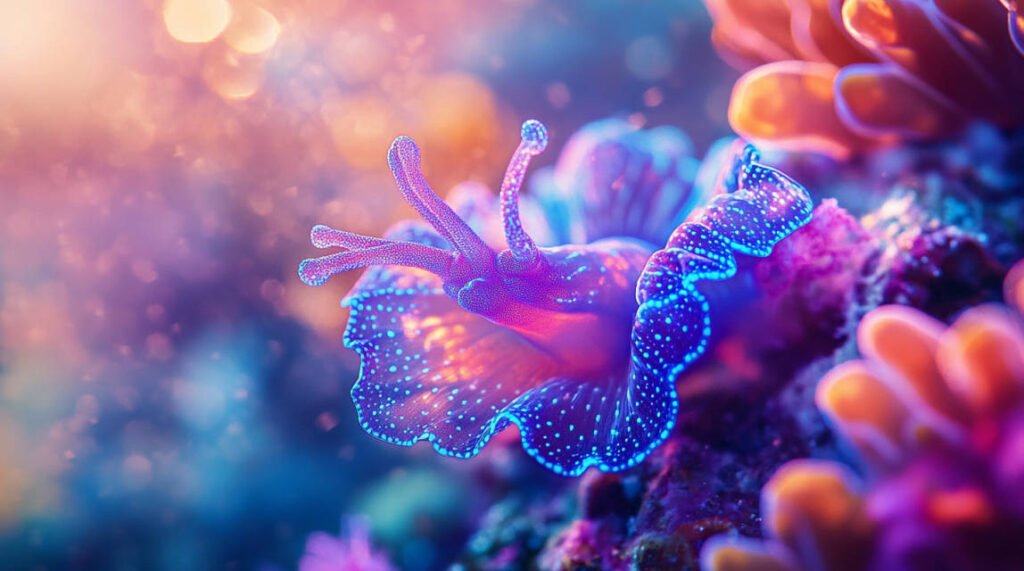
Dolphins: Playful Companions of the Deep
How dolphins interact with divers
Ah, dolphins—the ocean’s social butterflies! These intelligent marine animals are known for their playful and curious nature. I’ve had the incredible fortune of swimming with dolphins, and let me tell you, it’s an experience that sticks with you.
During a dive in the Red Sea, a pod of dolphins joined us out of nowhere. They were flipping and spinning, almost like they were putting on a show just for us. One even swam circles around me, making eye contact as if to say, “Isn’t this fun?” It was surreal!
Dolphins often interact with divers by mimicking our movements or bringing us objects like seaweed. They’re highly intelligent and seem to enjoy human company. But remember, they’re wild animals, and their interaction is always on their terms.
Prime locations to dive with dolphins
If diving with dolphins is on your bucket list (and it should be!), there are a few places you might want to consider. The Bahamas is famous for its Atlantic spotted dolphins. They often swim right up to snorkelers and divers, offering an up-close and personal experience.
Egypt’s Red Sea is another fantastic spot. Areas like Marsa Alam are known for frequent dolphin sightings. I also had an amazing time in Hawaii, where spinner dolphins are common. They get their name from their acrobatic spinning leaps—super cool to witness!
READ MORE: Best Red Sea Diving Spots: Underwater Paradise Awaits
Ethical guidelines for dolphin encounters
While it’s incredibly exciting to interact with dolphins, it’s crucial to do so responsibly. Always let them approach you; don’t chase after them. I know it’s tempting, but we have to respect their space. On one trip, I saw a group of tourists aggressively swimming toward a pod, and the dolphins vanished in seconds. Total bummer.
Avoid touching or feeding them. Not only is it harmful, but in many places, it’s also illegal. Choose tour operators that follow ethical guidelines and prioritize the well-being of the marine animals over profit.
Lastly, keep noise levels down. Loud noises can disturb or even harm dolphins. Enjoy the moment, soak it all in, and leave only bubbles behind.

Whale Sharks: Gentle Giants of the Open Ocean
What makes whale sharks so unique
Okay, let’s dive into one of my absolute favorite marine animals—the whale shark. Don’t let the name “shark” fool you; these guys are the gentle giants of the sea! Imagine swimming next to a creature the size of a school bus, yet as calm and serene as can be. It’s mind-blowing!
Whale sharks are the largest fish in the ocean, reaching lengths of up to 40 feet or more. But despite their massive size, they’re filter feeders, munching on tiny plankton and small fish. I still can’t get over the irony of such a colossal creature having such a tiny diet.
Their unique pattern of spots and stripes is like a fingerprint—no two are alike. Fun fact: researchers use these patterns to identify and track individual whale sharks. It’s like nature’s very own barcode system!
Seasonal migrations and where to find them
If you’re itching to swim alongside these magnificent marine animals, timing and location are key. Whale sharks are migratory, following the blooms of plankton-rich waters around the globe.
One of the best places to see them is Ningaloo Reef in Western Australia between March and July. I had the privilege of snorkeling there during peak season, and let me tell you, it’s an experience that stays with you forever.
Another hotspot is Isla Mujeres in Mexico, where hundreds gather between June and September. The Philippines, particularly Donsol Bay, is also famous for whale shark sightings from November to June.
How to safely swim alongside these enormous creatures
Now, swimming with whale sharks is a dream come true, but it’s crucial to do it responsibly. First off, always book with a reputable tour operator that follows ethical guidelines. On my trip to Ningaloo Reef, our guide was fantastic about keeping us informed on how to interact properly.
Maintain a minimum distance—usually around 3 meters from the side and 4 meters from the tail. Trust me, you don’t want to get whacked by that tail fin! Avoid touching them; their skin is delicate and can be harmed by human contact.
Be calm and move slowly. These marine animals are sensitive to sudden movements and loud noises. I remember one overzealous swimmer who splashed too much and the whale shark dove deeper, cutting our encounter short. Bummer!
Lastly, don’t use flash photography. It can startle them and disrupt their natural behavior. Keep these tips in mind, and you’ll have a safe and unforgettable experience swimming alongside the ocean’s gentle giants.
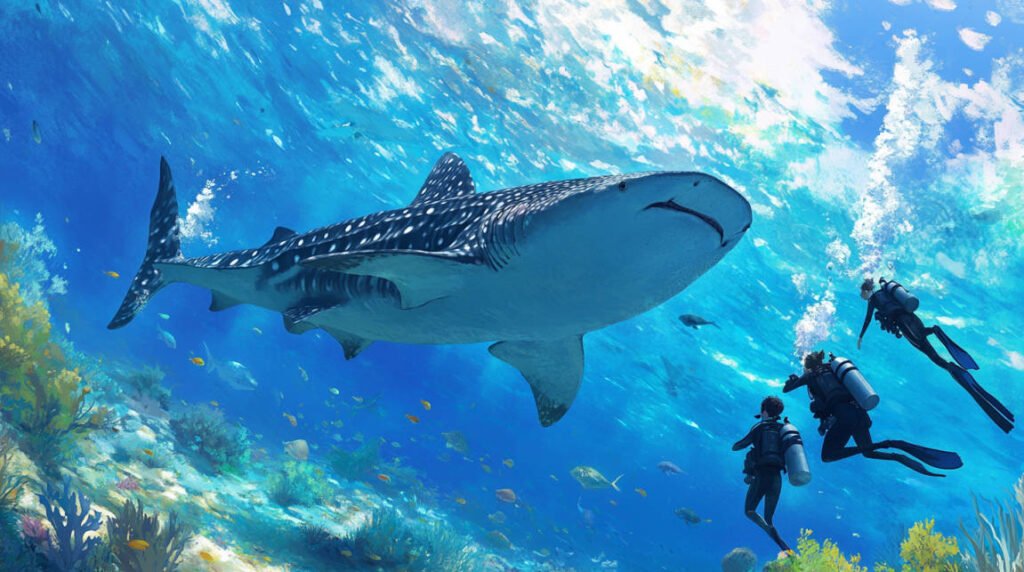
Octopuses: Masters of Disguise
The fascinating behavior and intelligence of octopuses
Octopuses are like the wizards of the underwater world—masters of disguise and incredibly intelligent. I mean, any creature that can solve puzzles, open jars, and even recognize individual humans deserves some serious respect!
These marine animals are known for their ability to change color and texture to blend seamlessly into their surroundings. I once spent a good five minutes staring at what I thought was a lump of coral, only for it to suddenly jet away in a cloud of ink. Startled doesn’t even begin to cover it!
Octopuses have been observed using tools, escaping from enclosures, and even playing. Their cognitive abilities are off the charts compared to other invertebrates. It’s like they’re the brains of the ocean.
How to spot an octopus in its natural habitat
Spotting an octopus can be a bit of a challenge due to their camouflaging skills, but that’s part of the fun! Look for subtle movements or odd shapes that don’t quite match the surrounding coral or rocks.
I usually scan for their distinctive eye shape or the telltale siphon tube they use for jet propulsion. Dusk and dawn are prime times since many species are more active during these periods.
Patience is key. On a night dive in Indonesia, I hovered near a rocky outcrop and was rewarded when a common octopus emerged to hunt. It was like watching a live episode of a nature documentary!
Common species divers might encounter, like the mimic octopus
There are several species you might come across, each more fascinating than the last. The common octopus is widespread and often found in shallow reefs.
But if you’re diving in Southeast Asia, keep an eye out for the elusive mimic octopus. This clever creature can imitate the appearance and movements of other marine animals like lionfish, sea snakes, and flatfish to deter predators. How cool is that?
The giant Pacific octopus is another remarkable species, found in colder waters like those off the coast of Alaska. They can grow to impressive sizes, with some weighing over 150 pounds!
No matter which species you encounter, observing an octopus in the wild is a truly special experience that underscores the incredible diversity of marine life.
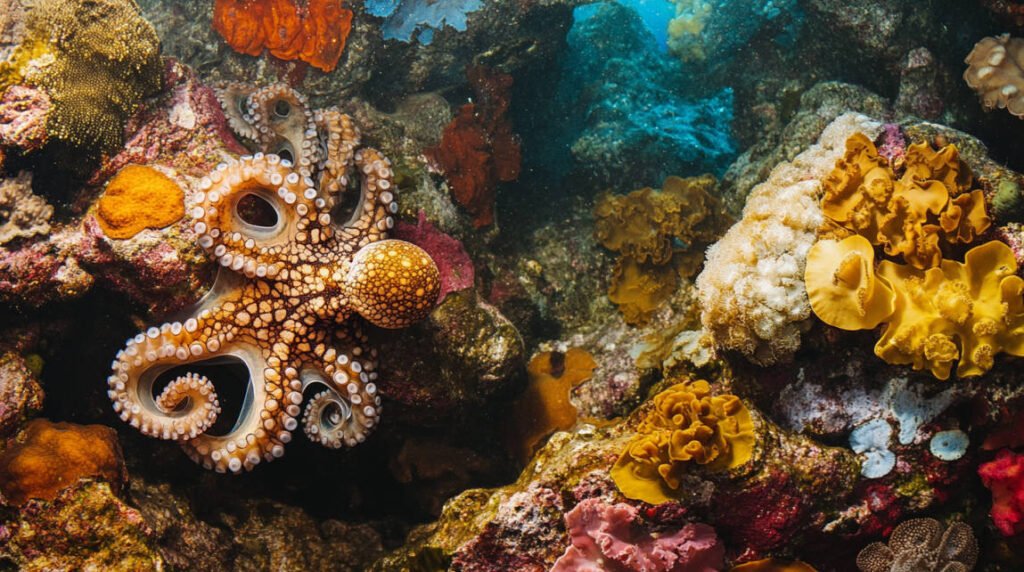
Bioluminescent Creatures: Nature’s Underwater Light Show
What causes bioluminescence and which animals display it
Bioluminescence is like the ocean’s very own light show, and it’s nothing short of magical. It’s caused by a chemical reaction within an organism that produces light. Many marine animals have this ability, from tiny plankton to deep-sea fish.
One of the most common culprits behind glowing waters is phytoplankton called dinoflagellates. When disturbed, they emit a blue or green light. It’s like swimming through a starry sky!
Other bioluminescent creatures include certain species of jellyfish, squid, and even some sharks. On a night dive, you might see comb jellies flashing like underwater neon signs or flashlight fish with glowing patches under their eyes.
Where and when to experience glowing waters
Experiencing bioluminescence is all about being in the right place at the right time. One of the most famous spots is Mosquito Bay in Vieques, Puerto Rico. It’s considered one of the brightest bioluminescent bays in the world.
I had an unforgettable experience kayaking there. Every paddle stroke ignited a trail of sparkling blue light. It felt like magic!
Other great locations include the Maldives, where bioluminescent plankton washes up on the beaches, creating a “Sea of Stars.” The waters around Koh Rong in Cambodia and Halong Bay in Vietnam are also known for their glowing plankton.
Timing-wise, darker nights with little moonlight enhance the visibility of bioluminescence. Warmer months often see higher concentrations of plankton, but it can vary, so checking local reports is a good idea.
Night diving tips for observing bioluminescent marine life
Night diving opens up a whole new world, and bioluminescence is one of the perks. Here are some tips to make the most of it:
First, get comfortable with night diving basics. Navigating in the dark can be disorienting, so it’s crucial to be confident in your skills.
Turn off your dive lights momentarily (when safe to do so) and wave your hands through the water to activate the bioluminescence. It’s like creating underwater fireworks!
Stay close to your dive buddy and maintain good communication. Night dives require extra caution, but they’re totally worth it.
Also, consider wearing a dark wetsuit and gear to minimize reflections and enhance the bioluminescent effect.
Remember, some marine animals are more active at night, so you might encounter creatures you wouldn’t see during the day. It’s an entirely different vibe that’s both peaceful and exhilarating.

Unique Marine Life by Region
Caribbean: From vibrant reefs to stingrays
The Caribbean is a diver’s paradise, brimming with vibrant reefs and a kaleidoscope of marine animals. Sites like the Cayman Islands offer crystal-clear waters teeming with colorful fish, corals, and sponges.
One of my favorite experiences was swimming with southern stingrays at Stingray City in Grand Cayman. These gentle creatures glide effortlessly through the water, and you can get up close and personal in a safe environment.
Don’t miss out on spotting seahorses, eagle rays, and the occasional reef shark. The warm waters and rich biodiversity make the Caribbean a must-visit region for any marine life enthusiast.
Pacific: Humpback whales and sea snakes
The Pacific Ocean is vast and varied, offering encounters with some of the most spectacular marine animals. Tonga, for instance, is one of the few places where you can swim with humpback whales. Let me tell you, being in the water with these giants as they sing their haunting songs is a humbling experience.
In places like the Solomon Islands and Vanuatu, you might come across banded sea kraits—sea snakes that are venomous but generally not aggressive. Always admire from a distance, of course!
The Pacific also boasts incredible coral reefs, manta ray cleaning stations, and an abundance of pelagic species. It’s a region that continually surprises and delights.
Arctic: Majestic belugas and narwhals
If you’re up for some cold-water diving, the Arctic offers unique marine life that’s unlike anywhere else. Beluga whales, known as the “canaries of the sea” for their vocalizations, are curious creatures that sometimes approach boats and snorkelers.
Then there’s the elusive narwhal, often called the “unicorn of the sea” because of its long, spiral tusk. Spotting one is rare and requires patience and sometimes a bit of luck.
Diving in the Arctic also means encountering other fascinating marine animals like walruses, seals, and various cold-water fish species. The icy landscapes and surreal underwater environments make it a truly otherworldly experience.
READ MORE: Essential Guide to Ice Diving in the Arctic
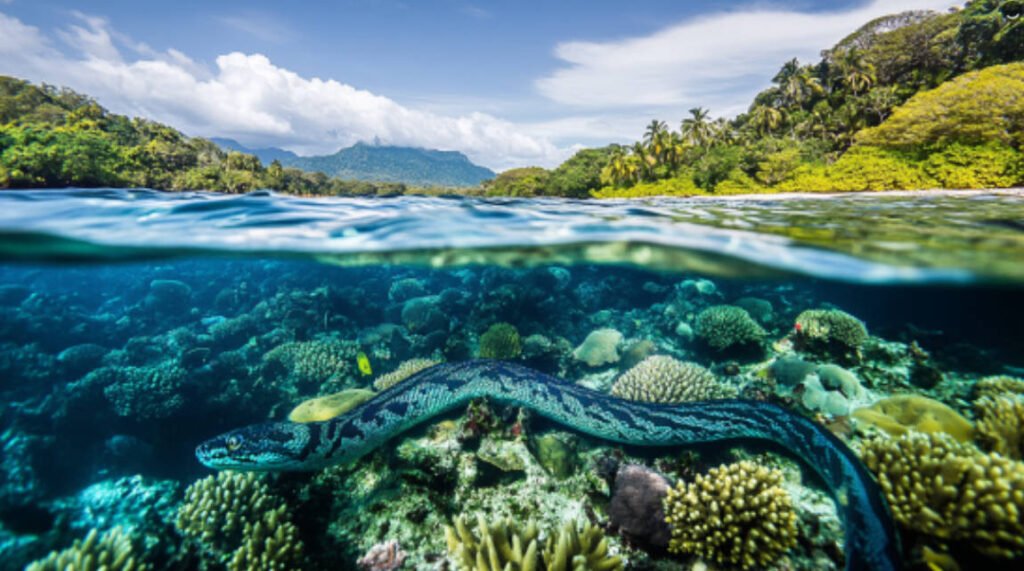
Conclusion
Diving gives us the extraordinary privilege of witnessing marine life in its natural habitat. From the vibrant coral reefs to the open ocean’s gentle giants, every dive is a unique opportunity to connect with the wonders of the underwater world. Ready to plan your next adventure? Dive into these incredible destinations and experience the magic firsthand. Don’t forget your camera—you won’t want to miss these unforgettable moments!

